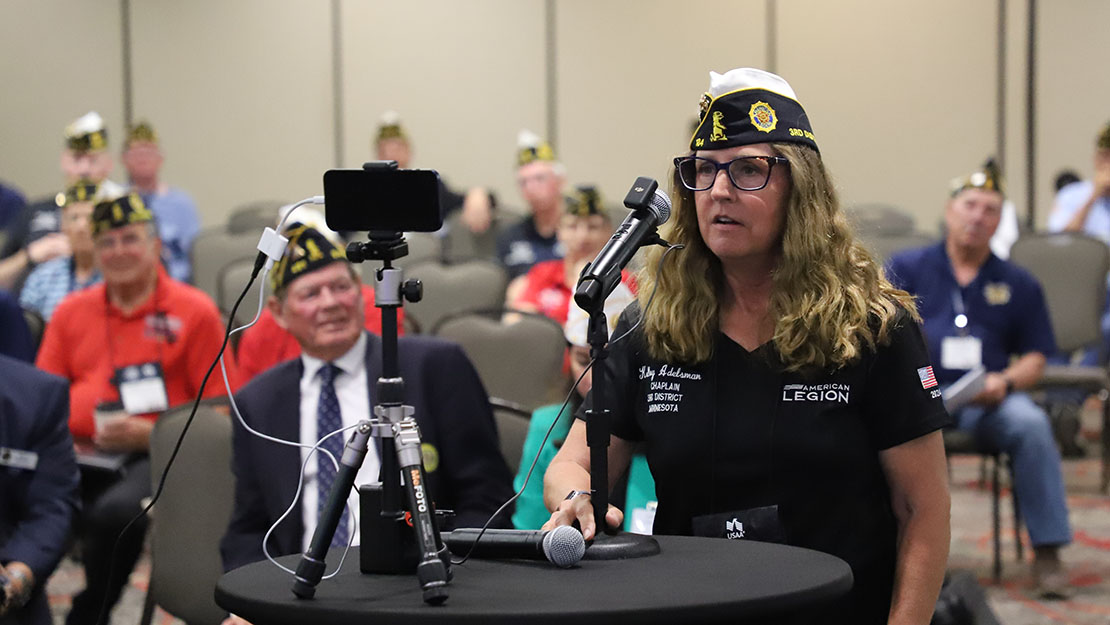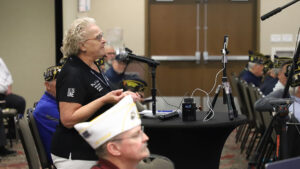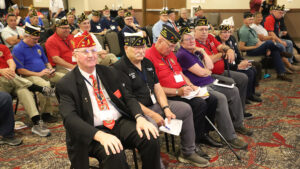105th Department of Minnesota Convention approves 8 resolutions

Should women and men have the same treatment for the wearing of Legion caps?
WILLMAR — The 105th American Legion Department of Minnesota Convention approved a resolution to remove language that separates American Legion female cap practices from males.
The voice vote on Friday, July 12, was so narrow that Commander Paul Hassing could not discern one side from the other. A hand count of delegates revealed a majority in favor of removing the language.
It was numbered Resolution 24-12 and states: “RESOLVED, to remove language in The American Legion Officer’s Guide & Manual of Ceremonies separating female uniform cap practices different from males, such as: ‘Female Legionnaires should wear their caps in the manner prescribed for women in the armed forces. This is suitable for most situations, but taste and common sense should prevail. By American Legion tradition, a female Legionnaire may leave her cap on during the Pledge of Allegiance, the national anthem, prayer and meals.’”
The resolution came from the 3rd District. Author Kelley Adelsman of Pine Island Post 184 said the military no longer requires different cap standards for men and women. She aimed to equalize uniform standards.
“A military person is a military person is a military person,” she argued.
Mary Jo York of Forest Lake Post 225 said The American Legion more important things to address. She said she is proud of her Legion cap and her military service.

“I find it difficult to believe I can’t eat a meal because my hat is on,” she said.
Veronica Fernlund of Waite Park Post 428 said she prefers the distinction between men and women. Men and women are different.
Teresa Ash of St. Paul Christie-DeParcq Post 406 said: “My uniform isn’t pink.”
She said, when she is on a date, she wants her husband to open the doors and pay the bill.
“However, when I am in uniform, I am an equal individual to every individual in this room,” she said.
The resolution, titled “Female Wearing of The American Legion Cap Exceptions,” now goes to national for consideration at the 105th National Convention, taking place Aug. 23-29 in New Orleans.
Here is a summary of seven other resolutions approved at the 105th Department of Minnesota Convention:
24-2: “Assessing the Effects of Anthrax Vaccinations on Veterans, Service Members and National Guard Personnel”
This resolution passed the Department of Minnesota last year. It comes from the Department VA&R staff following in-depth research reports from the U of M Brain Sciences Research Chair, which the Minnesota American Legion and Auxiliary founded.
Basically, the primary link for Gulf War syndrome is the anthrax vaccine veterans of that era received, the researched showed, and the resolution calls on the VA to do further research and to consider necessary steps of providing medical care.
At the 104th National Convention in Charlotte, the convention committee handling it said it needs to be broadened to include federal workers who received the experimental shot but were not servicemembers. The resolution being sent to New Orleans this year simply has the new language.
24-11: “Membership Annual Dues Increase”
Membership dues is one of those things that cannot be done by the Department Executive Committee and can only be done by the delegates during a convention.
The delegates approved a $3 increase effective at the close of the convention. The resolution came from the Department Finance Committee.
The portion of dues that go to the Department of Minnesota now is $16.75.
24-13: “National Convention Delegate Allotment”

The convention rescinded a 1949 mandate for the formula the Department of Minnesota uses for funding delegates to national conventions.
This is what the 1949 mandate said: “That the department shall contribute toward the delegates to national conventions on the basis of two delegates for the first four thousand members or major fraction thereof in each district and one additional delegate for each additional four thousand members or major fraction thereof in each District plus the regular delegates-at-large.”
The new formula provides equal amounts as set by the Finance Committee.
24-15: “VA Pension Program”
The VA’s disability pension program provides monthly payments to wartime veterans 65 years or older meeting certain criteria, which includes income. Presently, there is not a limit on how far back the VA can look at a veteran’s income to determine eligibility. However, with Social Security, the look-back period is generally five years.
This resolution notes the VA has been known to look back as far as 30 years, causing hardships. It calls for the Legion to set a limit of five years for looking back at income.
24-16: “Retroactive Payments for Delayed VA Claims”
The Department of Minnesota supports legislation that requires the VA to pay interest on retroactive payments owed to veterans for claims delayed a year or more. The resolution calls on the VA, Congress and others to support and implement this legislative change to ensure veterans receive the benefits they are due.
24-17: “Provide a Minimum Compensable Rating for Veterans with Service-Connected Hearing Loss Requiring Hearing Aids”
This resolution said the Department of Minnesota supports legislation to amend the current VA rating schedule to ensure that veterans with service-connected hearing loss who require hearing aids receive a minimum compensable rating of 40 percent.
The resolution calls on the national organization, as well as Congress, the VA and other stakeholders, to join in support of it.
24-19: “Advocating for the Increase of Specially Adapted Housing (SAH) and Special Housing Adaptation (SHA) Grant Rates for Veterans
SAH and SHA grants provide financial assistance to veterans with severe service-connected disabilities. However, the present levels do not fully cover costs of adapting homes to meet specific needs of severely disabled veterans, because of rising construction costs and the high expense of special modifications.
The resolution calls on the national organization, as well as Congress, the VA and other stakeholders, to review and adjust the rates and join the Department of Minnesota in support of it.


